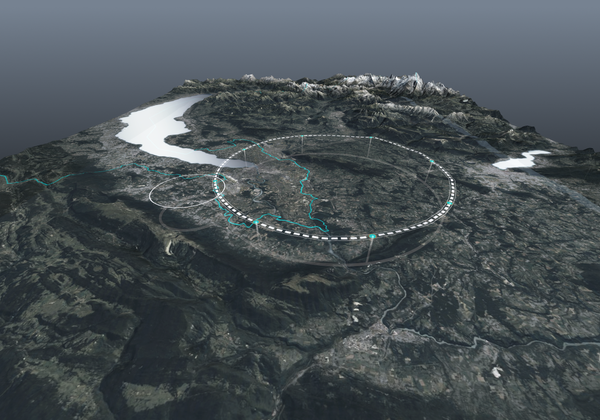February 7, 2024
4 min read
A feasibility study on CERN’s Future Circular Collider identifies where and how the machine could be built—but its construction is far from assured
By Elizabeth Gibney, Davide Castelvecchi & Nature magazine

The proposed Future Circular Collider, or FCC (large circle, dashed outline), would be built close to its predecessor at CERN, the Large Hadron Collider (small circle).
Europe is pushing forwards with plans to build a 91-kilometre-long, 15-billion-swiss-franc (US$17-billion) supercollider underneath the French and Swiss countryside. The machine would allow researchers to study the Higgs boson in detail. But scientists are under pressure to convince funders that such an enormous investment is worth it, following the lack of new physics revealed by the Large Hadron Collider (LHC).
Details of CERN’s plan emerged from a mid-term report studying the feasibility of the Future Circular Collider (FCC), which would dwarf its predecessor, the 27-kilometre LHC at CERN, Europe’s particle-physics laboratory near Geneva, Switzerland.
The first phase of the study — which focused on identifying where and how such a machine could be built in the CERN region — revealed “no technical or scientific showstoppers” that would prevent its construction, said Eliezer Rabinovici, president of the CERN Council, the organization’s governing body, at a press briefing on 5 February.
On supporting science journalism
If you’re enjoying this article, consider supporting our award-winning journalism by subscribing. By purchasing a subscription you are helping to ensure the future of impactful stories about the discoveries and ideas shaping our world today.
Construction of the machine, which will require boring a circular tunnel around 200 metres underground, could begin as early as 2033. The 91-kilometre-long tunnel, which the design suggests should be interrupted by four experimental halls, would encircle an area bigger than Chicago in Illinois. The council reviewed the report on 2 February, but the document itself has not been made public. The full study will be published next year, with a go or no-go decision on the project expected before 2028.
Former CERN director-general Chris Llewellyn Smith says he was puzzled by the decision not to publish the mid-term report, but he thinks that CERN is on the right track, “no question about it.”
“A great deal of detail has been filled out,” but the overall concept has remained consistent, which is “very reassuring,” adds Llewellyn Smith, a physicist at the University of Oxford, UK.
Smashing particles
The planned machine would collide electrons with their antimatter partners, positrons, from around 2045, with the aim of generating and studying in precise detail around one million Higgs bosons. Many physicists think that studying the particle, which was discovered in 2012 and interacts like no other, represents physics’ strongest chance of finding cracks in the standard model, a wildly successful but incomplete model of particles and forces.
Physicists called for a study into the feasibility of the FCC in 2020 as part of a prioritization exercise known as the European Strategy for Particle Physics. Fabiola Gianotti, CERN’s director-general, told journalists that the strategy found the FCC to be “the most compelling scientific instrument” of those it considered.
Building the FCC is far from a done deal. A large part of the 15-billion-swiss-franc price tag will be covered by the existing CERN budget, added Gianotti. But the project will still require financial contributions from the European countries that are full members of CERN, and from others such as the United States and Japan. The briefing did not provide any information on what these costs could be. “They seemed to be dodging giving specific numbers, like cost, and what might be shared by non-member states,” says Michael Riordan, a physics historian based in Eastsound, Washington.
More mega-colliders
Meanwhile, other ‘Higgs factory’ designs are in the works around the world. The Japanese government has shown interest in hosting the long-planned International Linear Collider, while China is designing a ring-shaped machine called the Circular Electron Positron Collider. Gianotti said that the European Strategy for Particle Physics had found that the FCC had greater physics potential than a linear collider, because it could produce Higgs bosons at a higher rate and because the same tunnels could later be used for a much higher-energy machine that collides protons.
Not everyone in the particle-physics community is in favour of CERN’s proposed machine. Donatella Lucchesi, a particle physicist at the University of Padua in Italy, disagrees with the organization’s focus on the FCC. “I don’t believe this is good for our community, for scientific and other reasons.” Lucchesi is part of a team studying an alternative technology for future colliders based on colliding beams of muons instead of electrons or protons.
Gianotti said that building the FCC would not prevent CERN from contributing to a muon collider, a facility an influential panel of US scientists said in December should be explored. Muons are much more massive than electrons, allowing for higher-energy collisions. But no one knows yet whether building a muon collider is even possible. “Of course we will now work with our US colleagues if they plan to build a new collider in the United States, but it’s on a timescale which is totally different from the timescale of the FCC,” she said.
Some scientists argue that the cost of building such mega-colliders outweighs their benefits, especially when theory gives no clear steer on what could be discovered. “It’s true that at the moment, we do not have a clear theoretical guidance on what we should look for,” said Gianotti, but she said this was an argument in favour of building a new machine. “The instruments will allow us to make a big step forward towards addressing the question, also telling us what are the right questions,” she said.
This article is reproduced with permission and was first published on February 6, 2024.
Note: This article have been indexed to our site. We do not claim legitimacy, ownership or copyright of any of the content above. To see the article at original source Click Here













